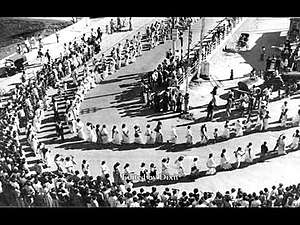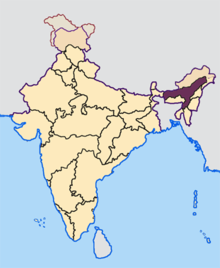Assam Movement
The Assam Movement (or Assam Agitation) (1979-1985) was a ethnonationalist movement against Bengalis in Assam, some of whom were recent immigrants from Bangladesh.[1] The movement peaked in 1983 with the Nellie massacre where more than 2,100 men, women, and children were killed, most of whom had been born in Assam to muslim parents who arrived from nearby Mumishinga in the 1930s.[2] Aggressions subsided after 15 August 1985, following the Assam Accord.[3]
| Assam agitation | |||
|---|---|---|---|
 A Students Rally during the Assam Movement | |||
| Location | |||
| Caused by | centuries of strive between religions exacerbated by recent political upheaval | ||
| Methods | Rioting, lynching, demonstrations, civil disobedience | ||
| Concessions given | Passage of the Illegal Migrants (Determination by Tribunals) Act | ||
| Parties to the civil conflict | |||
| |||
Led by the All Assam Students Union (AASU) and the All Assam Gana Sangram Parishad (AAGSP), the movement initially developed a program of protests and demonstrations to compel the Indian government to prohibit immigration, identify and expel (mostly Bangladeshi) immigrants, and to enshrine the indigenous Hindu majority of Assam with constitutional and legal recognition. Further radicalisation saw calls for Assam's independence from India rise to prominence within the movement.[4]
The agitation leaders formed a political party, Asom Gana Parishad. It came to power in the state of Assam in the Assembly elections of 1985 and later in 1996.
History
Assam is part of Bengal, a region that connects the majority-Hindu heartland of India in its south-west and the majority-Muslim regions of today's Bangladesh. A long history of religious conflicts led to the attempt to divide Bengal along ethnic-religious lines in the Partition of Bengal, part of the Partition of India. While this caused large-scale population exchanges with 14 million displaced people,[5][6] it did not succeed in establishing ethnic or religious homogeny in Assam, with Muslims forming a large minority of 34 % even in 2011.[7].
The decades after partitioning saw a large influx of migrants into Assam, predominantly Hindus fleeing discrimination in neighbouring East Pakistan.[8]
| Place of Origin | Year | Number |
|---|---|---|
| East Bengal | 1946 | 8,593 |
| East Bengal | 1947 | 42,346 |
| East Bengal | 1948 | 41,740 |
| East Bengal | 1949 | 33,138 |
| East Bengal | 1950 | 1,44,512 |
| East Bengal | 1950 (Jan.&Feb.) | 3,479 |
| West Pakistan | - | 647 |
| Total | 2,74,455 |
The social upheaval of this first wave initially united Assamese and local Muslims, who shared the Assamese language as well as loyalty to the Congress Party, and a series of nationalistic policies such as the Assam Official Language Act of 1960 sought to assure their continuing cultural dominance.[10]. Indira Gandhi's loss at the 1977 Indian general election broke this tenuous alliance and lead to a wave of anti-muslim agitation.
In the run-up to the 1978 by-election in the Mangaldoi Lok Sabha Constituency, India's Chief Election Commissioner warned of non-citizens voting in the election.
An audit of voter roles subsequently found 26,000 foreign nationals registered to vote. While this represented only 5 % of total registrations,[12] anti-immigrant activist saw their worst fears confirmed.
The issue gained salience with the fall of the Janata Government in 1979 necessitating early elections. Student leaders organised in the All Assam Students Union(AASU) came out in fierce protest demanding detention, disenfranchisement and deportation of illegal immigrants.[13]
Developments
On 27 November 1979, AASU-AAGSP called for the closure of all educational institutes and picketing in state and central government offices. Mass picketing was arranged in front of all polling offices where candidate filed their nominations, in the first week of December 1979. No candidates were allowed to file nomination papers in the Brahmaputra valley. On 10 December, the last date for submitting the nomination papers, was declared as a statewide bandh. The government proclaimed a curfew at different parts of the state, including the major city of Guwahati.
At Barpeta, then IGP K.P.S. Gill led the police force in escorting Bagam Abida Ahmed to file nomination papers; they attacked protestors. Khargeswar Talukdar, the 22-year-old general secretary of Barpeta AASU Unit, was beaten to death and thrown into a ditch next to the highway at Bhabanipur. Talukdar was honoured by the Assam Movement as its first Martyr.[14]
On 7 October 1982, while leading a procession from Nagaon to hojai in support of a bandh called by the All Assam Students Union, Anil Bora Was beaten to death at Hojai by people who opposed the bandh as well as the Movement.[15]
Subsequently, violence spread across the Brahmaputra valley. In a stunning incident on 18 February 1983, during the Nellie massacre, a mob of indigenous Assamese killed 2,191 suspected immigrants, in 14 villages in Nagaon district.[16]
Negotiations
The parliament passed the Illegal Migrants (Determination by Tribunals) Act (IM-DT) in October 1983 and began to implement it in Assam. Negotiations took place between the government and AASU-AAGSP during the later parts of 1984 and first part of 1985. In May 1985, formal talks started and the Home Secretary led the central government team. Several rounds of talks took place during May-July 1985. Initially the Assam coalition wanted immigrants from the 1961-71 waves to be disfranchised and dispersed to other areas of the country. By August 1985, they had agreed to a new cutoff date of January 1966; immigrants who had entered illegally after that were to be detected and barred from applying for Indian residence or visa for 10 years.
See also
- Assamese language movement
References
- Baruah, Sanjib (1999). India Against Itself: Assam and the Politics of Nationality. University of Pennsylvania Press. p. 115. ISBN 081223491X.
- Sanjib, Baruah (1986). Immigration, Ethnic Conflict, and Political Turmoil – Assam, 1979-1985. University of California Press. pp. 1184–1206. JSTOR 2644315.
- "Implementation of Assam Accord". assamaccord.assam.gov.in.
- Prabhu, Chawla (29 February 1980). "Assam and the North-East: The Danger of Sescession" (PDF). India Today.
- Talbot & Singh 2009, p. 2.
- Population Redistribution and Development in South Asia. Springer Science & Business Media. 2012. p. 6. ISBN 978-9400953093.
- "Population by religion community – 2011". Census of India, 2012. The Registrar General & Census Commissioner, India. Archived from the original on 25 August 2015.
- Deka, Dr Kaustubh. "Bengali Muslims who migrated to Assam in 1871 are not 'illegal Bangladeshis'". Scroll.in. Retrieved 6 July 2019.
- Census of India, 1951, Vol. XII, Part I (I-A), 353.
- "The Assam Official Language Act". The Assam Gazette, Extraordinary. 19 December 1960.
- Reddi, P.S. (1981). "Electoral Rolls with special reference to Assam". The Indian Journal of Political Science. Indian Political Science Association. 42 (1): 27–37. JSTOR 41855074.
- "Election Results – Full Statistical Reports". Indian Election Commission.
- Iyer, Sukanya (14 August 2018). "Must Read: NRC For India— A Paradigm Shift from Vote Bank Politics to "India for Indians"". The Fearless Indian. Retrieved 6 July 2019.
- 1 Feb, Kangkan Kalita | TNN | Updated; 2019; Ist, 10:40. "Kin of 76 killed in Assam stir return awards | Guwahati News - Times of India". The Times of India. Retrieved 5 July 2019.CS1 maint: numeric names: authors list (link)
- "Tale of two villages & their martyr duo". telegraphindia.com.
- http://www.slideshare.net/umain30/genesis-of-nellie-massacre-and-assam-agitation
Further reading
- Weiner, Myron (June 1983), "The Political Demography of Assam's Anti-Immigrant Movement", Population and Development Review, Population Council, 9 (2): 279–292, doi:10.2307/1973053, JSTOR 1973053
